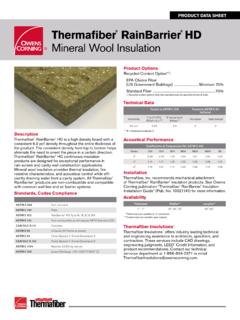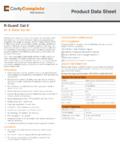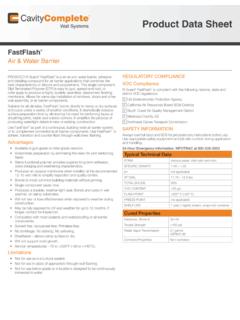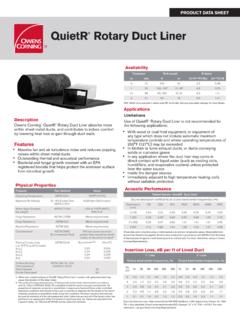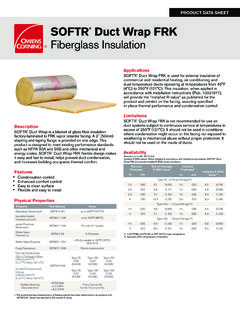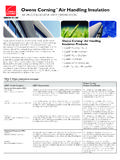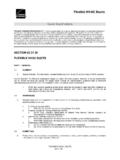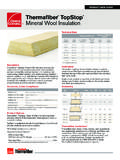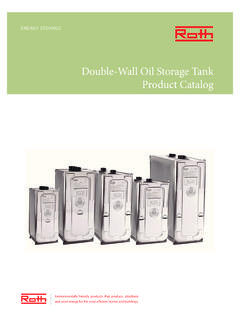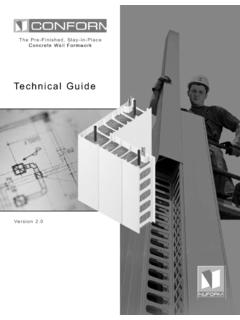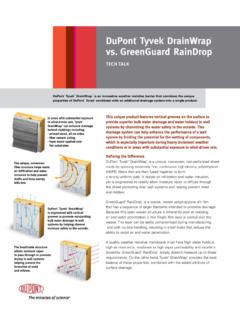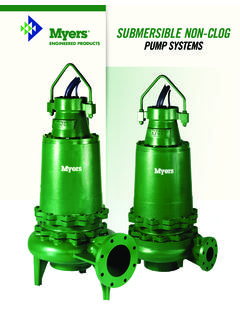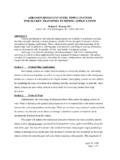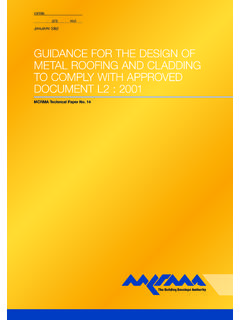Transcription of CAPTURING THE THERMAL PERFORMANCE OF FOAMULAR …
1 Q: Why is rigid foam insulation specified in exterior wall assemblies?A: When used in continuous insulation (ci) applications, rigid foam insulation increases the THERMAL resistance of the wall assembly by minimizing THERMAL bridging caused by framing members. For example, in an average wood frame construction, wood framing accounts for approximately 25 percent of the overall wall surface that is left un-insulated when only the stud cavities are insulated. Similarly, in steel framed construction, the steel not only interrupts the stud cavity insulation, it is also a very good conductor of foam insulation can be installed directly over framing members to provide continuous insulation coverage across the entire exterior of the wall. This approach enhances the THERMAL resistance of the wall and also reduces potential for moisture and mold issues within the wall : Why do cold months matter most when it comes to selecting a rigid insulation?
2 A: During cold winter months, buildings experience significant heat flow movement from inside to outside. To address this heat flow transfer, it s critical to specify a reliable insulation solution to achieve the desired energy efficiency, building PERFORMANCE and occupant comfort. New third-party research illustrates that Extruded Polystyrene (XPS) provides more reliable THERMAL PERFORMANCE than Polyisocyanurate (polyiso).Q: Can the Federal R-value Rule mislead specifiers regarding the actual THERMAL PERFORMANCE of rigid insulation? A: In some cases, yes. Across the industry, the Federal R-value Rule regulates that all R-value claims labeled and marketed for insulation products must be based on ASTM C518 tests . A standard mean temperature of 75 F is used when performing ASTM test methods for determining a material s R-value. In the case of rigid foam insulation, this can be has a published R-value of per inch and polyiso is listed at a range of to per inch.
3 These values are true when tested at a mean temperature of 75 F. However, building science research continues to show that the R-value of each product is substantially different when tested at colder mean temperatures. In other words, insulation R-value is temperature shown in the table below, the R-value of polyiso can decrease substantially when tested at mean temperatures less than 75 F. In contrast, the R-value of XPS can actually increase in colder temperatures. In fact, XPS outperforms polyiso in cold, winter months when it matters TemperatureXPSP olyiso75 Q: What new research substantiates that XPS exhibits better THERMAL PERFORMANCE than polyiso as temperatures get colder?A: Recently, Building Science Corporation (BSC) published the THERMAL Metric Summary Report regarding their THERMAL Metric Project and Reference Wall testing. The long-term goal of this project was to develop a new metric for the THERMAL PERFORMANCE of building enclosures that better accounts for known physical heat flow mechanisms (particularly natural and forced convection) and operating conditions.
4 This project included a focus on better understanding the THERMAL conductivity of insulating materials at different mean temperatures. The report reveals that the THERMAL PERFORMANCE of XPS and many other insulation types improves as the temperature drops. However, polyiso doesn t follow the same pattern. In fact, the BSC report illustrates that the THERMAL PERFORMANCE of polyiso declines substantially as the temperature part of their research, BSC tested the THERMAL conductivity of polyiso and several other building materials (See Figure 1). At 75 F, the mean temperature at which insulation R-values are reported on consumer packaging, the polyiso sample (shown as PIC Cartridge TB below) exhibits a level of THERMAL conductivity which correlates to its published R-value (R-value = 1 divided by its THERMAL conductivity, BTU-in/hr-ft2-F). CAPTURING THE THERMAL PERFORMANCE OF FOAMULAR EXTRUDED POLYSTYRENE (XPS) vs.
5 P O LY I S O CYA N U R AT E (P O LY I S O) FAQsHowever, as the temperature drops below 59 F, its THERMAL conductivity increases substantially which results in a significant decrease in R-value. In contrast, the THERMAL conductivity of XPS decreases as the temperature drops, resulting in an R-value that is ultimately greater than per 1. THERMAL conductivity test results from Building Science Corporation Q: Why does most polyiso perform so poorly when the temperature declines? A: The increased THERMAL conductivity and inconsistent PERFORMANCE of most polyiso is primarily attributed to the amount and type of blowing agent used in the product. The blowing-agent (insulating) gases that are entrapped within the cells of most polyiso begin to condense at colder temperatures and, as those gases condense, the THERMAL conductivity of the blowing agent and in turn, the polyiso blowing agent (insulating) gases that are entrapped within the cells of the XPS remain as a gas over the tested temperature range.
6 As the temperature gets colder the THERMAL conductivity of the gaseous blowing agent decreases and in turn, the THERMAL conductivity of the XPS decreases. Figure 2 uses averaged data to illustrate the effect of blowing agent boiling point on a foam s insulation value. This data demonstrates one of the advantages of low-boiling blowing agents: improved insulation PERFORMANCE over a broader operating temperature range. And, the better the insulation PERFORMANCE , the lower the energy consumption of products that rely on these high-value foam insulations. Due to this degradation of most polyiso s THERMAL PERFORMANCE in colder temperatures, builders and specifiers are paying a premium for a product that does not deliver on the intended THERMAL contrast, XPS is manufactured in a continuous extrusion process that produces a homogeneous closed cell crossed section. Even when exposed to freeze-thaw cycling conditions in colder temperatures, XPS maintains its closed cell structure and is virtually impervious to moisture, preventing loss of R-value due to moisture penetration.
7 Figure 2. Foam Insulation Value Versus Temperature for Liquid and Gaseous Blowing Agents Q: Since the R-value of polyiso is severely compromised in cold temperatures, how does polyiso ci compare to XPS ci in a typical wall assembly? A: Together with Building Science Corporation (BSC), the Owens Corning building science team used WUFI, a well-respected hygrothermal modeling program, to analyze the PERFORMANCE of XPS and polyiso in a variety of climates using BSC measurements. Three cold-climate locations in Chicago, Toronto, and Minneapolis were measured along with one hot-climate location in Miami. Exterior wall types (each with brick veneer cladding) were evaluated, including: 2x4 wood-framed, fiberglass-insulated wall with XPS continuous insulation 2x4 wood-framed, fiberglass-insulated wall with polyiso continuous insulationUsing the test data from BSC, the Owens Corning building science team ran WUFI simulations to take into account the actual THERMAL conductivity behavior of polyiso at different WUFI results for Chicago (Figure 3) are expressed in terms of heat loss and heat gain on a month-by-month basis.
8 As shown, both XPS and polyiso wall assemblies perform about the same during the summer. However, in the winter months, it s clear that walls built with XPS perform better than those constructed with polyiso. On an annual basis, the heat flow results show that 2 inches of XPS is 21 percent more efficient than polyiso (1 inch of XPS is 12 percent more efficient than polyiso).This testing conclusively found that the XPS (with a published R-value of per inch) performs 30 percent better than the polyiso (with a published R-value of per inch) at 50 F mean temperatures. In fact, measurements taken in Chicago during peak cold temperatures in December found that a wall with two inches of polyiso ci enabled 30 percent more heat flow through the wall versus the same wall with two inches of XPS. Figure 3. WUFI results for Chicago climate featuring heat flows (R10 board for both XPS and polyiso)35%30%25%20%15%10%5%0-5%-10%1234 567 Month89101112 XPS vs Polyiso5000-500-1000-1500-2000-250012345 67 Month89101112 Heat Loss, Btu/ft2 PolyisoXPSLoss GainHeat Flows - XPS vs.
9 PolyisoDifference in Heat Flow - Polyiso Heat Loss or Gain vs. XPSQ: How do XPS and polyiso water absorption properties compare? A: The material standard that defines properties for all XPS and EPS is ASTM C578. It requires that polystyrene insulation be tested for water absorption in accordance with ASTM C272. C272 requires the polystyrene sample to be immersed in water for 24 hours, and weighed immediately upon removal from immersion to determine the amount of absorbed water. The material standard for polyiso is ASTM C1289. It requires that polyiso be tested for water absorption in accordance with ASTM C209. C209 requires the polyiso sample to be immersed in water 2 hours, and drained for 10 minutes before weighing for water absorption. Figure 4 shows the significant differences in XPS and polyiso water absorption that result from using different measuring techniques. Note that the water absorption level for polyiso increases greatly when tested by the same method used for XPS.
10 Glass faced polyiso goes from absorbing 14x more water than XPS, to absorbing 30x more water than XPS, when measured using the same method. Foil faced polyiso goes from absorbing more water than XPS, to absorbing over 7x more water than XPS. Because the presence of foil makes such a difference in water absorption, the long-term durability of the foil is critical. If the foil is punctured or corrodes while in service, the polyiso core is unprotected from water, and is even more prone to higher water absorption, like the condition with glass : Why does water absorption resistance matter when it comes to selecting a rigid insulation? A: Moisture gets into all types of buildings. Unless the building insulation is highly resistant to water absorption, moisture can degrade insulation R-value, structural integrity and provide an essential ingredient to support mold growth. Water is a good conductor of energy, so if insulation is water soaked, R-value is lost.
